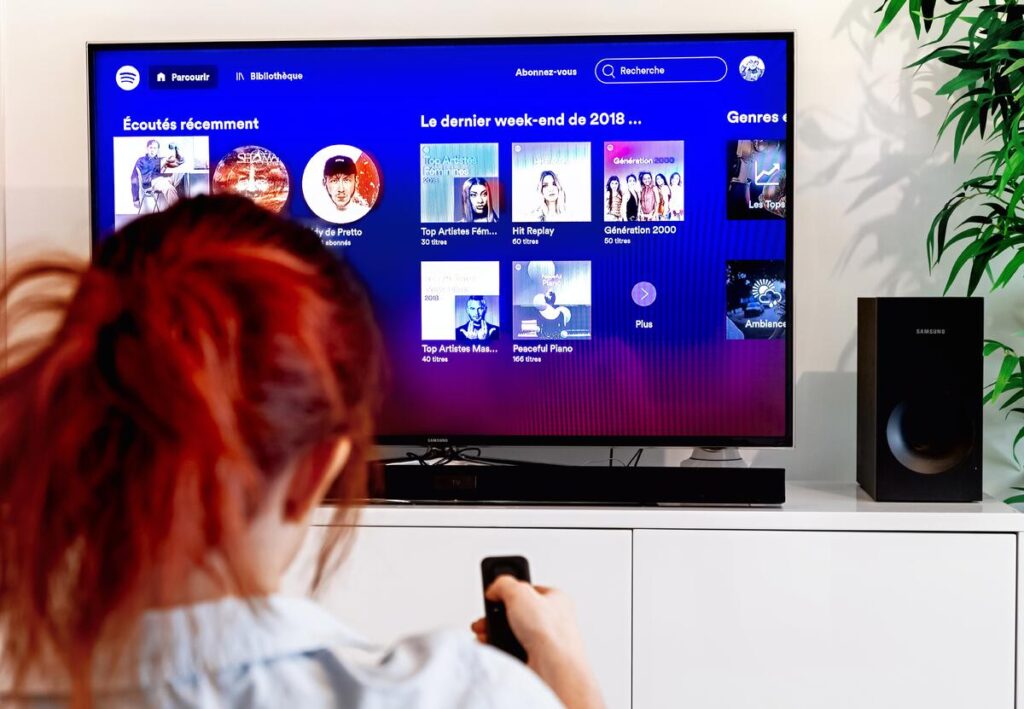Do OLED TVs Need A Soundbar? (Explained)
Disclosure: Tech Parasol is supported by its readers. When you purchase through links on our site, we may earn an affiliate commission. Thank you.
- Soundbars are recommended for OLED TVs because TV speakers generally aren’t big enough or powerful enough to produce great sound.
- Some OLED TVs such as those made by Sony do produce good sound because the entire screen acts as a speaker.
OLED TVs are known for their amazing picture quality, but one thing that’s perhaps discussed to a lesser extent is their audio quality.
So, do you need a soundbar with an OLED TV or is the audio from these TVs “good enough”?
Well that’s exactly what you’re about to find out in this article.
Let’s get to it.
Soundbars are recommended for OLED TVs and TVs in general. OLED TVs in particular are very thin and generally only have space for two small speakers. These aren’t big enough or powerful enough to produce great quality sound.

I will caveat that by saying that some TV speakers sound better than others. And some TVs can sound pretty good even without a soundbar.
But there are some good reasons why you’d want to invest in a soundbar for your OLED TV which we’ll look at in the next section.
Reasons for using a soundbar with an OLED TV
Here are some reasons why you should consider investing in a soundbar for your OLED TV.
Better sound quality
Most soundbars sound better than the speakers that come bundled with an OLED TV.
Speakers in many TVs simply aren’t big enough or powerful enough to produce great sound.
This is especially the case with OLED TVs that have bezels that are so thin that there simply isn’t room for large speakers.
TVs usually also only have two speakers with a maximum output of just 20W. These tend to be “midrange” speakers that are almost a “jack of all trades” when it comes to sound reproduction.
This means that although they can handle a wide range of sound frequencies, they aren’t able produce deep bass sounds like a subwoofer can.
Neither can they compete with speakers that specialize in treble sounds.
The placement of speakers in TVs is also an issue.
TV speakers tend to be either on the bottom or on the back of the TV. So the sound is never actually projected towards you.
OLED TVs, because they are light and thin, also tend to be wall mounted. But this can muffle the sound making it especially hard to hear dialog.
Soundbars have multiple speakers
Most sound is recorded into 5 channels of information. However, most TVs only have just two speakers.
So those 5 channels of information are combined so that they can be heard through your TV’s 2-channel system.
This can make it difficult to understand dialog in movies and TV shows.
Soundbars are different. They have a number of speakers inside them and are able to reproduce audio using all 5-channels worth of information.
Some soundbars are also able to produce virtual surround sound by projecting sound around a room.
They can even make the sound come from behind you as if there were speakers there!
Subwoofer often included
When you buy a soundbar, you often get a subwoofer included.
Subwoofers are large speakers that can be hidden away behind your TV stand.
They’re responsible for those big booming bass sounds that you get in movies during explosions or thunderstorms.
Getting one of these can really add depth to the movies you watch and enhance your overall experience.
But they can also take some of the load away from the other speakers too which are better suited to mid and high frequency sounds.
Some soundbars even have subwoofers built-in and additional drivers to provide a center channel.
Easy to set up
Unlike traditional home theater solutions that require complicated setups, soundbars are self-contained units that can be connected up to a TV quickly and easily.
With HDMI ARC (Audio Return Channel), all you need is a single HDMI channel between the soundbar and the TV and you’re set (and the power cable of course).
Do OLED TVs produce good sound?
Some OLED TVs such as the LG C1 can produce “good” sound.
OLED TVs like other TVs often rely on clever Digital Signal Processing (DSP) techniques to compensate for their lack of large, powerful speakers.
The LG C1 for example is equipped with AI surround sound that gives the illusion that there are speakers placed around the room.
Although the audio can sound okay, it will never be a match for a decent soundbar or a home theater system.
Do OLED TVs have surround sound?
OLED TVs do not have true surround sound because there aren’t enough speakers built-in.
True surround sound literally means having a speaker in every corner of the room projecting high-quality audio at you.
However, OLED TVs such as the LG C1 and the LG G1 can have virtual surround.
This can give you the illusion that there are speakers placed around you.
Do you need a soundbar with a Sony OLED TV?
Not necessarily because Sony OLED TVs use Acoustic Surface Audio technology.
These TVs take built-in audio to a whole new level by vibrating the glass panel of the TV effectively turning it into a speaker.
And it does this in such a way that’s invisible to the human eye, so you won’t be seeing the TV dance to the very music that it’s playing!
You also have a subwoofer on the back of these TVs that fires deep bass sound forwards.
The sound produced by these TVs is also sent in your direction, as opposed to being projected to the rear of the TV or the floor.
This is the case with rear-facing or downwards facing speakers that you get in most TVs.
But does this make the TV sound as good as a soundbar? According to whathifi.com, it’s the “next best thing” to a soundbar.
And on Reddit, some people have said that it’s easily as good as a budget soundbar but not a match for something more high-end.
What is the best soundbar for an OLED TV?
The best sounding soundbar for most people and one that works well with an LG OLED TV is the Sonos Arc.
The Sonos Arc produces fantastic, balanced audio that excels when it comes to dialog reproduction.
The Arc is also capable of producing deep bass without the need for an additional subwoofer.
It will never be a match for a fully-fledged home theater system with a receiver, but it’s certainly the next best thing.
And if you want to take things to the next level, then you buy a Sonos subwoofer to go with it.
Adding a subwoofer will allow the Arc to concentrate more on the higher frequency sounds associated with dialog, background effects and music.
So you’ll get more clarity and of course deeper booming bass sounds that you’d expect from a subwoofer.
But as with any product, there are downsides.
For example it only has a single HDMI port and your TV will require Dolby Atmos support to experience Dolby Atmos sound on the Arc.
If your TV has eARC though, you’ll be able to enjoy uncompressed 5.1 and 7.1 audio.
So, if you want a high performance soundbar to go with a great picture on your OLED, then look no further.
Here’s a summary of the features:
- Supports Dolby Atmos.
- Contains no less than 11 drivers and 5.0.2 channels!
- Well-balanced speaker that produces deep bass sounds without a subwoofer.
- Dialog reproduction is incredible.
- Super easy to set up and integrate into a multichannel or multiroom system should you choose to do so.
- The Sonos app tunes the soundbar for a particular room.
- Only has a single HDMI port with no-pass through, meaning that you will lose a HDMI port on your TV.
- Your TV must be able to decode or pass through Dolby Atmos sound.
Sources
No soundbar? Buy a Sony OLED TV with Acoustic Surface Audio+ | What Hi-Fi?

Robert Anderson
Robert Anderson, the founder of Tech Parasol, had a keen interest in tech from a very young age. He studied Electronic Engineering at University and then went on to become a Software Developer. He launched Tech Parasol in 2021 to share his knowledge with the aim of making tech easier to understand for everyone.

